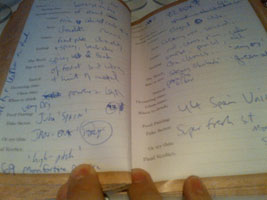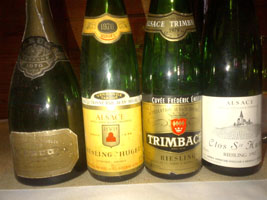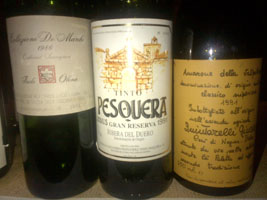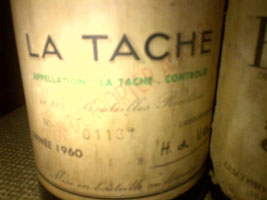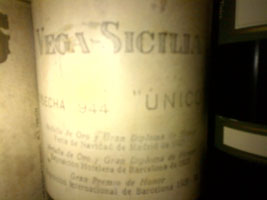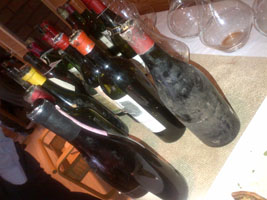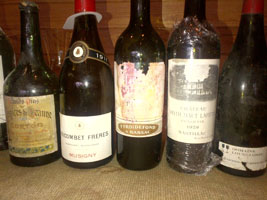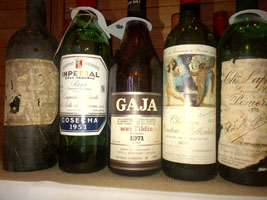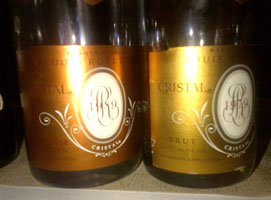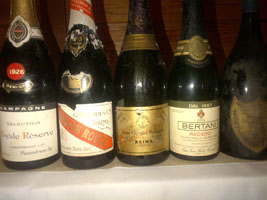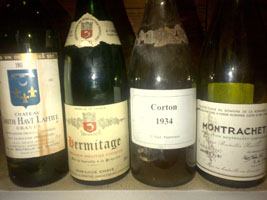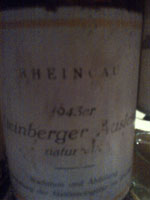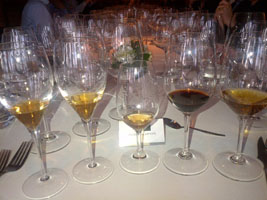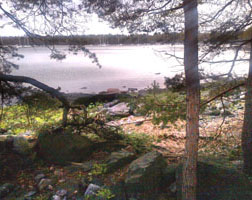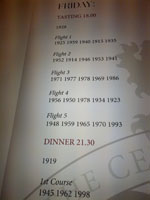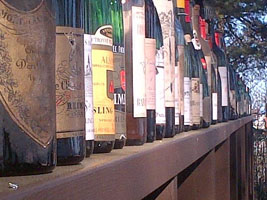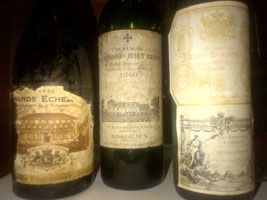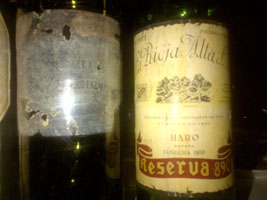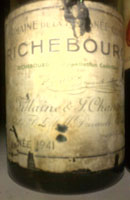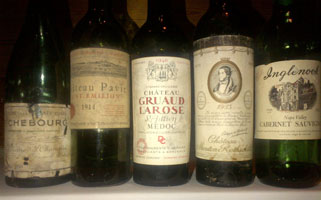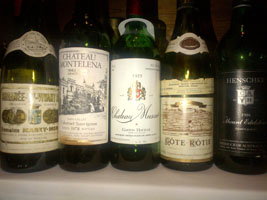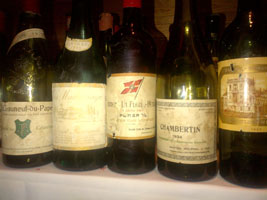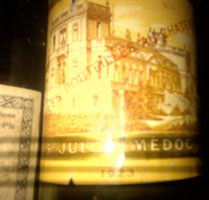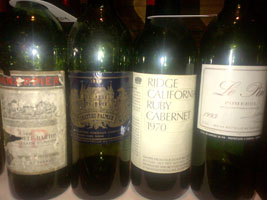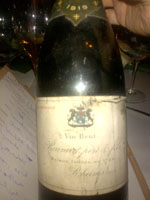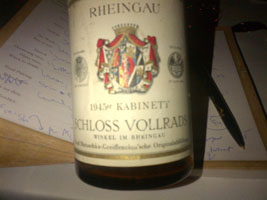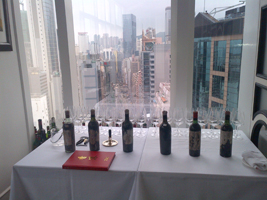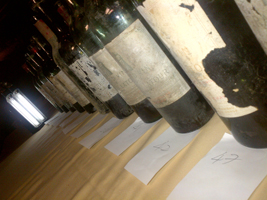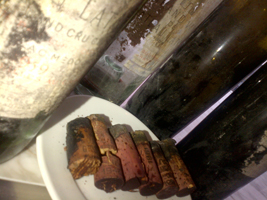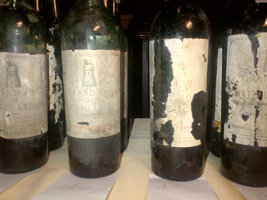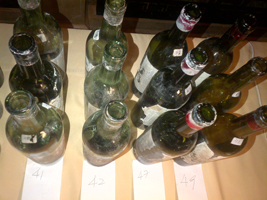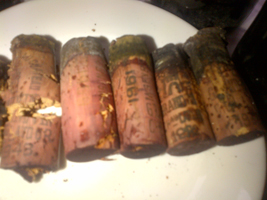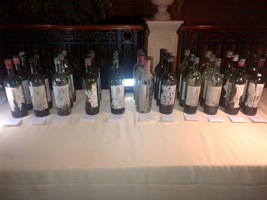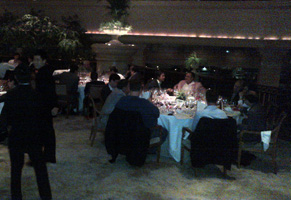Man, I need to start writing up the nights where there are four, six or eight wines more often. I would get a lot more articles done that way, although I have been tweeting notes for a lot of those nights, follow me @JohnKapon if you want to get more of those. I think I have at least 400+ new wine notes on Twitter from this past year alone, but I digress. ..
Tasting Of The Year 2012 – Part III
One of my signature moves is to write up two parts of a three part tasting and let part three slip into the lost tasting files, but not this time! This was the Tasting of the Year dagnabbit, and I will finish this! That was my own version of self-motivation, and with the most historical retrospective of Petrus EVER waiting in the wings, I had to pull myself away from those 57 vintages to finish the 37 wines we had on Day Three of the Tasting of the Year.
We began on the windy docks outside in the crisp, cold air with some 1907 Heidseick Gout Americain, the original shipwrecked Champagne. Its color was great, someone needs to start an underwater storage facility . It had an apple-y nose with lots of sweet sugar; of course, the ‘Gout Americain’ was intended to be sweeter to satisfy the tastes of Americans at that time. The palate was also sweet, full of yellow fruits, but the finish had a touch of morning mouth at first. It brushed its teeth and developed into honey and gunsmoke and was long and polished with solid acidity despite being more wine-like than bubbly (94).

The Final Day Begins
We went inside to start with a 1906 Montrose that had an old, oaky nose that was way too much for me in the beginning; it was bordering on sickly and interior wax, but it blew off into the nut and cassis direction. The palate had old flavors of nutty ice cream and caramel kisses to go with wafer and wood. This was a tender, old wine that still had something to say at age 106 (92).
The next wine was served out of magnum, and its nose seduced me immediately. It gave me an impression similar to 1968 Unico with its thick and chunky caramel personality, along with black forest fruits. The palate was much lighter and more its age, which was 1916 btw, and while mild, it was still delightful. The 1916 Brane Cantenac magnum was smooth, lightly gritty and grainy with pepper and leather flavors, but it lightened rapidly in the glass and was a two-minute man, so to speak (90M).
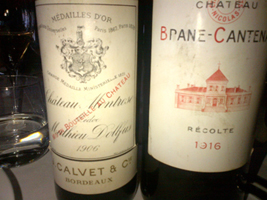
On the Sixes
We changed gears to a flight of whites with a fascinating nose that reminded me of old Bordeaux. The glue jumped out immediately, along with fantastic painted room, honeycomb, musk and a whole stick of butter. It was very complex, and we got a clue – this was the first vintage ever of this wine. The palate was great, full of honey and soft, round and chalky on its finish. There was this touch of askew to the palate, but it was still delicious. SuperSomm noted, ‘caramalized apple,’ and Pekka admired its ‘gentle’ personality. It was a 1920 Pavillon Blanc de Chateau Margaux. Wow, that might have been the last bottle on Earth (94).

Two Thrilling Whites
The second white was equally as fascinating. It had a fresher, more youthful nose compared to the 1920, but it still possessed mature, warm fruit with lots of alcohol and acidity. Someone noted, ‘rubbery,’ while another found it to be an ‘Yquem- style, but not the sweetness.’ Apricot, nut, honey and warm toast were both in the mouth and on the palate, and it was so Yquem, as it should have been because it was a 1968 Ygrec, Yquem’s dry white! This was another delicious white Bordeaux, so viscous, with a hint of benevolent bitters to its finish. We all need to age our white Bordeaux more, as this great wine from a theoretically horrible vintage proved (95).
A couple of sweet wines ended the lunch portion of our program, beginning with a wine that emitted ‘cloudberry and white truffle.’ It was really complex and reminded me of an old Riesling, and there was this almost smoked ham quality to go with citrus and apricot jam. The palate was sweet, oily and creamy, and 98s and 99s were coming from the crowd for this viscous, yet not heavy, white. ‘Fresh peach and raspberry’ came from the crowd. After some time, I determined that it wasn’t Riesling, it wasn’t Sauternes, it was beautiful, satiny and polished, it being a 1921 Bredif Collection Vouvray. Impressive (96).
The next wine wasn’t so impressive. White Port, Madeira, Massandra, Sherry and Vin Santo were all written by me, each followed by ‘ish.’ It was awkward and angular and made me frown when I tasted it; the aromas were much better than its flavors, if you could even call them that. It was a 1910 Leone Bianchi Marsala Vecchio Amabile Riserva. That’s a lot of names for a wine I could call a lot of names. I guess we should keep Marsala for cooking (NR).
The tasting began with an old nose, one that was still really nice, ‘a pleasant surprise’ per Pekka. Despite it clearly being old, it was fresh with vimful acid and rose and blood aromas. Pekka continued that it was ‘the best wine from vintage I have tasted.’ Hmmmm. The palate was a touch metallic on the finish, but that blew off into excellent acidity and citricity. There were big-time tobacco flavors on its hot n spicy palate, and it got leathery with a touch of locker room, pointing me in Italy’s direction. Juha added ‘orange peel’ for this amazing 1902 Luigi Arnuleo Barolo. This was your grandfather’s Barolo lol (93).
The next red was open, aggressive and weedy with lots of coffee aromas. Nonetheless, it was deep and alluring, but a bit nervous like the Girl with the Dragon Tattoo. Its soft palate had a flash of lush coffee flavors, a medium-body and a splash of water. Flavors of cereal, caramel and coffee were all present in this 1922 Martinez Lacuesta Rioja Reserva Especial, which got a bit herbal in the glass (91).
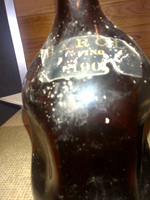
Your Grandfather’s Barolo
We were back to Italy with a simple and disappointing 1967 Biondi Santi Brunello Riserva. The nose seduced at first in a shows a little, says a lot way, but its palate was watery, light and uncomplicated. Red fruit, citrus, tomato and leather were all there in average fashion (85).
The fourth wine of this first flight was clearly a big-time Rhone with its citrusy, meaty and peppery nose. There were lots of tangy red fruit aromas, and it was pungent in a great way. The palate was identical with animal, ham and garden joining the party, and it still had excellent acidity. Its rich personality held in the glass as menthol flavors developed. It was a wine from a ‘rustic vintage,’ it being a 1975 Jaboulet Hermitage La Chapelle. Good show (95).
The last wine of the first flight was full of asparagus, which somehow degenerated into Golden Showers in our distinguished group. Its exotic, wild nose had grilled pea shoots and pheromones running around, and Super Mario noted ‘more vegetal qualities’ while Juha noted ‘candy.’ There were milky flavors and ‘Asian action’ on the palate, which had me leaning towards something South African. The palate became quite herbal, and asparagus took over there as well in this interesting 1979 Wynn’s Coonawarra Estate Cabernet Sauvignon (90).
The next flight was ‘the first vintage flight,’ meaning every wine tasted was its first vintage, pretty cool. Unfortunately, the 1968 Sassicaia was cooked and (DQ).
The next wine would ultimately prove to be my wine of the weekend. While I am not one who drinks Rhone wines regularly enough to be called a ‘lover,’ I have fallen in love with the 1966 Guigal Cote-Rotie La Mouline, seeing it defeat some of the greatest Burgundies and Bordeaux in battle time and time again. I believe this is the fifth time I have had this wine, and it has never been less than glorious. Its sexy nose dripped with mint, violet and bacon, which signaled the Rhone direction right away. Everything about this wine was spectacular – its richness, balance and acidity were all practically perfect. Hints of licorice emerged on the palate, giving it just the right twist. I couldn’t stop drinking it until it was sadly gone. It is definitely a candidate for my Top Ten wines of all time (99).

The First Vintage Flight
The next wine had me guessing La Turque, but it was far from it. Its deep, heavy nose had lots of black fruits and a touch of gingerbread. Its palate was round, fat and inky but also flabby, with nice cherry flavors on its finish. This was a 1985 Ornellaia (91).
I think the La Mouline took over my senses for a few minutes, as I was then convinced that the next wine was La Turque as well, 1985 of course. The nose was pepper city, and its palate was chunky, rich and long. SuperSomm noted ‘so licorice’ and ‘green vegetal,’ and I noted a moldy confectioners quality. I was stunned to learn this was a 1988 Dalla Valle Maya! ‘Impressive, but doesn’t compute,’ ended my note (93).
For the final wine in this first vintage flight, my tastebuds recalibrated, as I guessed Italian, and it was, a 1988 Il Caberlot. I think this wine had a special significance for Pekka, but I can’t recall. The Caberlot was very leathery, with tasty caramel flavors and a gritty, rocky, minerally finish (92).
The next flight got serious with a trio of big-time Bordeaux, starting with a 1937 Ausone that was reconditioned in 2000 at the Chateau. Bacon fat jumped out of the nose, more on the lard side. This was a bit of a dirty birdie, in a good way. Aromas of wheat, oats, chocolate and horse intertwined in a complicated yet beautiful way. Juha noted, ‘rosemary focaccia,’ and the ’37 was smooth, long, full and elegant all at once. Batman found it to be ‘a British wine,’ while the CFO noted, ‘tobacco.’ It was a good job of reconditioning, even though everyone knows I always prefer the original. I am sure that twelve years of extra bottle age definitely helped its natural, mature qualities to come back to the forefront (94).

A Fab Five
I guessed the next wine to be 1961 Latour, but it was a glorious 1953 Lafite Rothschild instead I can live with that . It had a deep, intoxicating nose, one that Bordeaux dreams are made of. There was impressive power and t ‘n a here, which is why I thought it was the ’61 Latour. Juha hailed it as ‘so aristocratic’ and ‘complete.’ Its cedar flavors were divine on its gritty palate, which also had this slaty grind to it. Dry, old cassis balanced the cedar perfectly in this great bottle. The most interesting fact shared about this legendary vintage for Lafite was that the Chateau bottled over the course of a year, leading to possible bottle variation (98).
The next wine was actually decanted four hours prior, which possibly affected its score. I understand the theory behind lots of air to make a wine ‘open,’ but it also softens a wine where its intensity factor can be compromised. I would rather decant an old wine repeatedly over and over if it needs more air time as opposed to keeping it open that long, but that’s just me. Pekka found it, ‘so thick.’ It was almost disdainfully nutty, along with aromas of wheat, cereal, chocolate and a pinch of port. The palate was thick, rich, oily and gritty, chock full of sparkle. Other comments for this 1962 Vega Sicilia Unico included, ‘not ready yet,’ ‘tannins puckering,’ and ‘not as complete.’ I couldn’t help but wonder if I would have given it a point higher if it had a little less air time, as usually this wine has me around 95 points (94).
Batman was all over the ‘melted butter’ in the next wine. It had a wow nose, rich and ‘Montrachet good,’ per Juha. It was almost toxically good, and the palate didn’t disappoint either, producing a tasty, rich and heavy rock n’ roll experience. I was waiting for the 1961 Latour to show up, Pekka’s #1 wine of all-time, one that he’s had over 100 times. That’s sexy and I know it (96).
The last wine in this stellar flight was a 1972 Penfolds Grange It had ‘a Syrah feeling but not Rhone,’ someone noted, along with ‘ripe blueberry’ and ‘salt licorice.’ It had a bacony, minty nose, and while it was a bit Rhony, it was more concentrated, possessing a sweet red cherry and eucalyptus two-step. It gained in the glass (94).
The final flight of the last tasting portion of our program began with a wine that had a ‘cabbage-y’ nose per SuperSomm. There was also some mildew and cork, and almost a touch of botrytis. There was a sweet core behind its mildew qualities, and bandaids joined the program. The palate was nice, with lingering acid, ‘gorgeous’ per one, possessing ‘bird milk’ per Juha. I tried to think if I had ever had bird milk. Wait a second, do birds even produce milk? The 1938 Clos des Lambrayswas excellent despite some handicaps, and it got dirty on the finish, which, of course, always helps a man finish (93).

The Hits Keep Coming
The next wine had a unique, seductive nose with exotic qualities of garden, date, game, yogurt and a red fruit rainbow. There were delicious strawberry flavors and solid acid. This was sweet, sexy shit. I guessed 1970 Rayas, but it was a 1970 Henri Jayer Vosne Romanee, back when the Cros Parantoux was still going in the Vo Ro, I believe. Dirk Diggler said, ‘he wouldn’t but he did.’ Not sure the context anymore, but I found it important enough to write down, so there you go (95).
A bottle of 1974 Heitz Martha’s Vineyard Cabernet Sauvignon was much better than the magnum I had had a couple months prior, and this bottle came apparently direct from Heitz. This was a classic and what this wine is all about with its mint and chocolate 1947 Mouton character. Asphalt and eucalyptus flavors combined on its rich, heavy palate. When it gets this old, it’s all about the bottle (96).
The next wine was a 1989 Haut Brion, which was incredible as always. I have written up the greatness of this wine so many times, I only found it necessary to write ‘what else is new?’ Juha added, ‘hot stones from a dry season’ (98).
And so ended the last tasting portion of our program, and so began the dinner and final chapter of this legendary weekend. But first, we had a magnum of 1964 Salon, which had a great nose fill of white sugar, butter, ice and diamonds. The front palate was pure and clean with caramel flavors developing, but its finish was a bit yeasty with morning mouth. Was it a kiss oxidized? Something was off, unfortunately, and despite the color, nose and attack being outstanding, something was amiss at the end (94A-M).
Dinner began with a ‘young Sauvignon Blanc,’ but although it was Sauv Blanc, it wasn’t that young, at least for the grape. Aromas of grass, grapefruit, cat’s pee, gooseberry and rye bread were all present in this pungent white. The palate had sweet pineapple and passionfruit flavors and a ripe and racy finish. This was a pure and tropical wine that was impressively fresh, given the fact that it was a 1999 Cloudy Bay Sauvignon Blanc (92).
The next two whites were cross dressers, as I thought the first was Burgundy and the second Rhone, and it was the exact opposite! The first of the two whites had old notes of mature wood, cobwebs, butter and milk in its nose. The palate had nice richness, with tasty and creamy cantaloupe flavors, along with solid acidity. This 1989 Jaboulet Hermitage Blanc Chevalier de Sterimberg was buttery, gamy and fully mature, seemingly older than it was, but liked by me nonetheless (93).
The 1984 Lafon Meursault Charmes had an exotic Rhone-like nose with candle and beeswax, glue, kinked fruit and game. The palate was meaty and oily, with ‘dry brass’ and ‘old hay’ flavors per Super Mario. Its game flavors were great, and while it was missing a bit of acidity, this Rhone impostor from a terrible vintage was quite good and still playing its song (93).
There was one more white, and it had honeyed nose that was musky and perfumed. There was eskimo action here that made me want to snuggle in an igloo, and great fruit that got more complicated. The palate was sweet and tropical, clean and citrusy, ‘viscous’ per SuperSomm, along with asparagus flavors and a minerally finish. Petrol started to dominate in this 1957 Gobelsburg Gruner Veltiner Private Reserve (93).
The next wine was Pekka’s epiphany wine, the 1984 Caymus Cabernet Special Select. I believe he was doing a photo shoot for Mick Jagger, and Mick was drinking it and shared a glass with him. The rest is wine history! It’s amazing how one moment can change the course of someone’s life, and Pekka received his personal emotional rescue from the big guy himself. The nose was all about the caramel, with that asphalt edge of Cali Cab, while the palate was rich and sweet, with grapy, caramel flavors (92M).

Pekka Gets Some Satisfaction
Finally, we landed in RC territory. I was beginning to think it was going to be excluded from the weekend, but I should have known better. The 1955 DRC Romanee Conti had autumnal aromas of rust, truffle and a sweet, brown core. There were tasty ice cream flavors along with wormy, tree bark ones. ‘Nice juice,’ came from the crowd, and this flirty Pinot was arguably a touch advanced, but it wouldn’t let you know it once you closed your eyes and opened your mouth. Tasty and balanced, its acid came out of hiding and lifted into a great, energetic finish (96+).
The next wine was a stunningly and surprisingly good 1999 Rousseau Clos de la Roche. This is a wine that people basically ignore in the Rousseau portfolio, and after one sip of this 1999, I have no good reason why that is! This was pure 1999 at its best with perfume and cherry sex appeal going with loads of vitamin as well. There were oceans of concentrated fruit in this oily and sexy now wine with great pitch and substance. This was absolutely delicious, although it did lose a step or two in the glass over time. This was still a wow wine for me (94).
The 1994 Screaming Eaglecaused a bit of controversy, with Dirk Diggler giving it 84 points and saying, ‘this Screaming Animal is so disgusting.’ Yikes! I think that was a bit extreme, and everyone certainly didn’t agree, myself included. It had a nice, balanced nose with caramel, boysenberry, asphalt, spice and a blue streak of fruit. ‘Over ripe’ and ‘port’ came from the crowd, and it was what it was – a ripe Napa cab with sweet, fleshy flavors. It lacked a bit of nuance on the palate (93).
And that was the last red wine of the weekend, but there were still some bubblies and sweeties to go. A 1996 Krug Clos du Mesnilhad aromas of vanilla cream, toast and yellow ice cream. There were straw and hay flavors, along with vanilla, and ‘wow’ and ‘wonderful’ came from the crowd. It was a bit more approachable than most memories that I have of this legend, but I wasn’t complaining (97+).
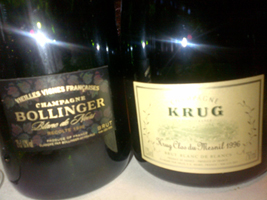
Champagne Dreams
I thought the 1998 Bollinger Vieilles Vignes Francaises was a Clos des Goisses, oh well. It was long and zippy, fresh and citrusy with nice tang. There were snowcapped vitamin flavors in this excellent yet young bubbly. The great Champagnes are better to drink when 1996 and older, for now (93).
Five dessert wines to go. I think I can, I think I can. The first was a touch oxidized, but it was supposed to be as it was a 1904 Arbois Vin Jaune from the Jura, which makes oxidized styles of wine to begin with. The flavors were dry and awkward, varying from lanolin to morning mouth to sherry to Comte cheese. Pucker up and blow lol (82).
A 1939 Massandra White Muscatis about as good a Massandra as I can remember. Aromas of chamomile and honey were lush and so sweet, and its oily texture gave off a hedonistic vibe. Someone noted, ‘Cantonese chicken with bamboo’ in this wild wine (95).
The 1903 Oliveiras Madeira Boal Rservaat first reminded me of sniffing glue or rubber cement, but tea took over. There was crazy power in this Hugo Chavez of a wine. It was powerful with thundering acidity, and sweet chocolate flavors rounded it out well. Who was I kidding? Nothing could round this out; its power and acidity were next level. Of all the dessert wines, Madeira is probably my favorite (96).
Was the next port? But it smelled almost like a cognac. There was lots of acid and a touch of mint in this semi-sickly ‘oil painting’ of a wine. It was a 1912 Niepoort Colheita Port (91).
SuperSomm got up and called the weekend ‘an act of humanity’ and how great it was to share history together. It was a nice speech, but we told him to sit his ass down because the 1900 Yquem was coming. Aromas of candlewax, cobweb, butterball and dry toffee were all present in this ‘elegant’ Yquem. There wasn’t too much of anything in this rather restrained Sauternes, and its lovely balance had some finding it fantastic. It wasn’t too sweet, and perhaps it suffered being served after the Madeiras and Ports and such, but it was still excellent (93).

1900 Yquem Closer of the Year
It was a weekend that I will never forget, one I will take with me to the end of my time here. That is the greatness of fine wine, to give memories that last a lifetime, associations of friends and places that will never be forgotten. Many thanks to Pekka for a most memorable weekend; if only you could turn 50 every year.

Lineup of a Lifetime
In Vino Veritas,
JK

